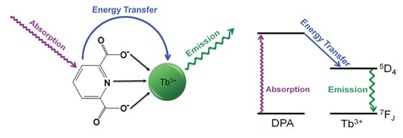Terbium-DPA Luminescence Assay


Bacterial spores (endospores) have been shown to be highly resistant to UV, heat and chemical treatments, making them important biomarkers for sterility and bioterrorism. Dipicolinic acid (DPA) is a major component of spores, and is speculated to help protect the cell's DNA, as well as facilitate germination. Furthermore, DPA is a spore-specific molecule, so the presence of DPA is a clear indicator of endospores. Our lab uses terbium (Tb) luminescence for the detection of DPA. Under UV excitation, Tb3+ ions alone are not very luminescent as this excitation is Laporte forbidden; however, upon complexation with DPA, bright green luminescence is easily observed. The spectra allows us to  quantify an amount of DPA, which, in turn, corresponds to a number of spores. This method of endospore detection could potentially be used to assess the sterilization of spacecraft, to fight bioterrorism, and to search for life in extreme environments.
quantify an amount of DPA, which, in turn, corresponds to a number of spores. This method of endospore detection could potentially be used to assess the sterilization of spacecraft, to fight bioterrorism, and to search for life in extreme environments.

publications
Detection and viability assessment of endospore-forming pathogens. Ponce, A.; Connon, S.A.; Yung, P.T. In Principles of Bacterial Detection: Biosensors, Recognition Receptors and Microsystems, Eds. Zourob, M.; Elwary, S.; Turner, A., Springer Science Business Media, 2008.
Towards an in-situ endospore detection instrument. Shafaat, H.S.; Cable, M.L.; Ikeda, M.K.; Kirby, J.P.; Pelletier, C.C.; Ponce, A. IEEE Aerospace Conference, 2005. [PDF]
